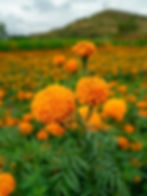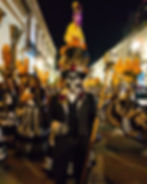Exploring the Traditions and History Behind Día de Muertos
- chtopete
- Jun 1
- 5 min read
Updated: Jul 16
Día de Muertos, or the Day of the Dead, is a vibrant and meaningful celebration that honors departed loved ones. It combines ancient Aztec traditions with Catholic elements, creating a unique cultural tapestry. Celebrated primarily in Mexico and among Mexican communities worldwide, this holiday has gained international recognition for its colorful altars, intricate decorations, and deep symbolism. In this blog post, we will explore the history, traditions, and significance of Día de Muertos.
Día de Muertos: A Cultural Overview
Día de Muertos is observed on November 1 and 2, coinciding with the Catholic holidays of All Saints' Day and All Souls' Day. The holiday reflects a blend of indigenous beliefs and Spanish influence. For many, it is a time to remember and celebrate the lives of those who have passed away.
Families create altars, known as ofrendas, adorned with photos, mementos, and favorite foods and even drinks or cigarettes of the deceased. These offerings invite spirits to return for a brief visit, filling the atmosphere with joy and remembrance rather than sorrow.

This connection to the past enriches the community, reminding everyone of their shared history and cultural roots. It emphasizes the cyclical nature of life and death, showcasing the belief that death is not an end, but a continuation of the journey.
The Historical Roots of Día de Muertos
The origins of Día de Muertos can be traced back thousands of years to the Aztec civilization. The Aztecs honored their deceased ancestors through rituals and ceremonies, believing that death was an integral part of life. They viewed the afterlife as a continuation, where the souls of the departed could guide and influence the living.
With the arrival of Spanish colonizers in the 16th century, many indigenous traditions were suppressed. However, cultural resilience allowed for the merging of customs. Catholic elements, such as celebrating the saints and the souls in purgatory, were incorporated into the existing practices, creating the rich tapestry of Día de Muertos celebrated today.
Historians note that this blending of traditions reflects the adaptability of cultures. In contrast to the somber tone associated with death in many parts of the world, Día de Muertos embraces a festive spirit, allowing families to celebrate life and death together.
Key Traditions of Día de Muertos
Altars or Ofrendas
Central to Día de Muertos celebration is the creation of altars, or ofrendas. These decorative displays serve as a tribute to the deceased. Common elements include:
Photographs: Images of the loved ones being honored.
Food: Traditional foods such as bread (pan de muerto), fruits, and favorite meals of the departed.

Traditional Oaxacan pan de muerto decorated with vibrant, colorful figures, symbolizing the Dead, head and body, a rich cultural heritage in celebration of Día de los Muertos. Candles: Symbolizing hope and guiding spirits back to the living.
Marigolds: Bright orange flowers are believed to attract the souls of the dead.

The inclusion of these elements facilitates a dialogue between the living and the dead. Each altar tells a unique story, illustrating the personality and passions of those being honored.
Calacas, Calaveras & Catrinas
Calacas (skeletons) and calaveras (skulls) are prominent symbols during the holiday. These figures are often depicted in playful, whimsical ways, reflecting the belief that death is not to be feared but embraced.
You may find decorations that feature calacas engaging in everyday activities, like dancing or playing music. The playful nature of these images symbolizes that death is merely a transition into the next stage of existence. One of the most iconic representations is La Catrina, a female skeleton elegantly dressed in fancy clothes and a wide-brimmed hat. Created by Mexican illustrator José Guadalupe Posada and later popularized by Diego Rivera, La Catrina satirizes those who aspired to adopt European aristocratic traditions, reminding us that death comes for everyone, regardless of status. Today, La Catrina serves as a powerful symbol of both equality in death and the joyful spirit with which Día de los Muertos is celebrated.
Parades and Celebrations
In many towns and cities, festive parades take place during this period. Participants often wear colorful costumes, paint their faces like skulls, and engage in lively music and dancing. These events foster a sense of community spirit, enabling everyone to come together to honor their ancestors collectively.
Statistics from recent years indicate that participation in Día de Muertos celebrations has increased significantly, with thousands attending parades in cities such as Mexico City and Oaxaca. This growth highlights a rising appreciation for cultural heritage and identity among younger generations.
One of the most vibrant expressions of Día de los Muertos in Oaxaca can be seen in the comparsas of Etla, Oaxaca. A comparsa is a traditional street procession that features dancers, musicians, and costumed participants, often lasting all night and into the early morning hours. In Etla, these parades are known for their elaborate masks, brass bands, and satirical performances that blend reverence and revelry. The comparsa is not only a form of celebration but a creative expression of remembrance and cultural continuity.

The Significance of Food
Food plays an essential role in Día de Muertos. Traditional dishes are prepared and offered to the deceased, reflecting their preferences and favorite meals. Some of the popular foods include:
Pan de Muerto: A sweet bread often shaped like a skull and decorated with sugary bone-like pieces.
Mole: A rich sauce made from chocolate and spices, often served with turkey or chicken.
Sugar Skulls: Colorful edible skulls adorned with icing, representing the sweetness of life.
By sharing these foods, families foster a sense of connection between the living and the deceased. The act of sharing a meal is symbolic of unity and remembrance.
How to Celebrate Día de Muertos
Celebrating Día de Muertos can be a profoundly personal and meaningful experience. Here are some actionable recommendations for those who wish to honor this tradition:
Create an Ofrenda: Start by setting up a small altar at home. Include photographs, favorite foods, and meaningful items for your loved ones.
Get Involved in Community Events: Look for local parades, festivals, or events celebrating this holiday. Engage with the community and learn from others. A special way to do this is by joining a Day of the Dead tour with Fundación En Vía
Learn About Your Ancestry: Take time to research your family's history. Understanding your roots can deepen your appreciation for Día de Muertos.
Prepare Traditional Foods: Try cooking traditional recipes. Invite friends and family to join you in sharing these meals.
Attend Workshops: Many communities offer workshops on making sugar skulls or crafting traditional decorations. These can be fun ways to immerse yourself in the culture.
Embracing the Spirit of Día de Muertos
Día de Muertos is more than just a holiday; it is a powerful expression of love, remembrance, and cultural identity. Through the vibrant customs, families celebrate the lives of those who have passed while fostering a sense of unity and connection among the living.
This holiday serves as a poignant reminder that death is not an end, but a transition, encouraging us to cherish our memories and the legacies of those who have come before us. By participating in Día de Muertos, we can honor the past while keeping the spirit of our loved ones alive in our hearts.
By engaging in the traditions of Día de Muertos, we not only preserve our culture but also create a space for reflection and connection. Let us celebrate this beautiful fusion of history and memory, ensuring that those we love will never be forgotten.
For more information on the history and celebrations of the Day of the Dead, consider the Our Day of the Dead Spanish Immersion program in Oaxaca.
